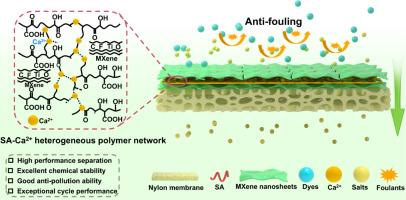Molecular Insights in Outstanding Performance of Ca2+ bridging MXene/Sodium Alginate Composite Membranes
IF 12.4
1区 环境科学与生态学
Q1 ENGINEERING, ENVIRONMENTAL
引用次数: 0
Abstract
The efficient separation of organic dyes and inorganic salts poses higher requirements for the high permeability and selectivity of membrane separation technology. This study developed a stable MXene/sodium alginate (SA) composite membranes via Ca2+ bridging, achieving high water flux (270.78 ± 2.06 L·m-2·h-1·bar-1) and excellent dye rejection (≥ 99.5%) for multiple dyes, while maintaining low salt rejection (< 12%) and a high selectivity factor S(EB/NaCl) = 783.1. Moreover, the MXene/SA composite membrane exhibited strong chemical stability and antifouling performance. After soaking in different pH solutions and the organic solvent (ethylene glycol) for 48 hours, it still maintains a underwater oil contact angle (UOCA) ≥ 145°. The flux recovery rates (FRR) after filtering humic acid (HA) and bovine serum albumin (BSA) reach 86.53% and 90.52% respectively. The anti-fouling mechanism of MXene/SA composite membranes was further expounded by using the extended Derjaguin-Landau-Verwey-Overbeek (XDLVO) theory. The results of molecular simulation and density functional theory (DFT) calculation show that the regular arrangement of SA molecular chains induced by Ca2+ and the strong coordination effect enable the formation of tighter and more uniform nanochannels within the membrane, thereby enhancing the molecular sieve separation effect and rejection. Molecular simulation further reveals that Ca2+ mainly distributes at ∼3.06 Å from SA, with strong binding energy (-258.1 kJ/mol) and high coordination efficiency (each Ca2+ bridging ∼1.5 SA monomers), which stabilizes the cross-linked network and improves membrane performance. This work provides a valuable insight for the treatment of wastewater containing organic pollutants with high-performance separation membranes.

Ca2+桥接MXene/海藻酸钠复合膜优异性能的分子研究
有机染料与无机盐的高效分离对膜分离技术的高渗透性和选择性提出了更高的要求。本研究通过Ca2+桥接制备了一种稳定的MXene/海藻酸钠(SA)复合膜,对多种染料具有较高的水通量(270.78±2.06 L·m-2·h-1·bar-1)和优良的染料去除率(≥99.5%),同时保持低盐去除率(<;12%),高选择性因子S(EB/NaCl) = 783.1。MXene/SA复合膜具有良好的化学稳定性和防污性能。在不同pH溶液和有机溶剂(乙二醇)中浸泡48小时后,仍保持水下油接触角(UOCA)≥145°。腐植酸(HA)和牛血清白蛋白(BSA)过滤后的通量回收率(FRR)分别达到86.53%和90.52%。利用扩展的Derjaguin-Landau-Verwey-Overbeek (XDLVO)理论进一步阐述了MXene/SA复合膜的抗污染机理。分子模拟和密度泛函理论(DFT)计算结果表明,Ca2+诱导的SA分子链的规则排列和强配位效应使膜内形成更紧密、更均匀的纳米通道,从而增强了分子筛的分离效果和排斥性。分子模拟进一步表明,Ca2+主要分布在SA的~ 3.06 Å处,具有较强的结合能(-258.1 kJ/mol)和较高的配位效率(每个Ca2+桥接~ 1.5个SA单体),稳定交联网络,提高膜性能。这项工作为高性能分离膜处理含有机污染物废水提供了有价值的见解。
本文章由计算机程序翻译,如有差异,请以英文原文为准。
求助全文
约1分钟内获得全文
求助全文
来源期刊

Water Research
环境科学-工程:环境
CiteScore
20.80
自引率
9.40%
发文量
1307
审稿时长
38 days
期刊介绍:
Water Research, along with its open access companion journal Water Research X, serves as a platform for publishing original research papers covering various aspects of the science and technology related to the anthropogenic water cycle, water quality, and its management worldwide. The audience targeted by the journal comprises biologists, chemical engineers, chemists, civil engineers, environmental engineers, limnologists, and microbiologists. The scope of the journal include:
•Treatment processes for water and wastewaters (municipal, agricultural, industrial, and on-site treatment), including resource recovery and residuals management;
•Urban hydrology including sewer systems, stormwater management, and green infrastructure;
•Drinking water treatment and distribution;
•Potable and non-potable water reuse;
•Sanitation, public health, and risk assessment;
•Anaerobic digestion, solid and hazardous waste management, including source characterization and the effects and control of leachates and gaseous emissions;
•Contaminants (chemical, microbial, anthropogenic particles such as nanoparticles or microplastics) and related water quality sensing, monitoring, fate, and assessment;
•Anthropogenic impacts on inland, tidal, coastal and urban waters, focusing on surface and ground waters, and point and non-point sources of pollution;
•Environmental restoration, linked to surface water, groundwater and groundwater remediation;
•Analysis of the interfaces between sediments and water, and between water and atmosphere, focusing specifically on anthropogenic impacts;
•Mathematical modelling, systems analysis, machine learning, and beneficial use of big data related to the anthropogenic water cycle;
•Socio-economic, policy, and regulations studies.
 求助内容:
求助内容: 应助结果提醒方式:
应助结果提醒方式:


